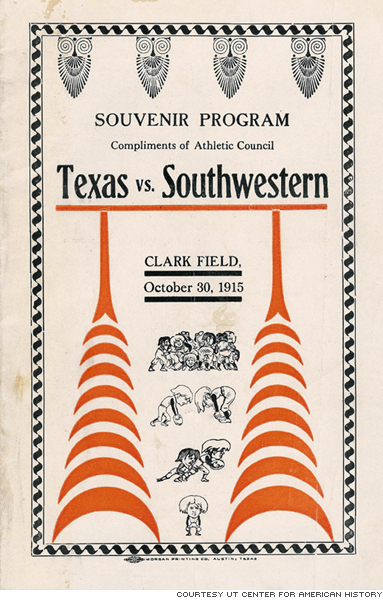1910-1919
The second decade of the twentieth century began with the hiring of a new coach, W.S. Wasmund, who’d played quarterback for Michigan and planned to teach the Michigan system to Texas. With the support of wealthy team manager Lutcher Stark, Wasmund’s 1910 Longhorns went 10-2 against a tough schedule of opponents, and the school was pleased enough to rehire him for the 1911 season. Wasmund introduced the first pre-season training camp (held at Marble Falls in 1911), but when he returned to campus, disaster struck. Just six days before the opening game of the season, he was found lying on the ground, having apparently fallen from his second-floor apartment. Wasmund died from his injuries several days later. Although foul play was suspected, his death was ruled an accident after several Longhorn players told authorities that their coach was a sleepwalker.
Wasmund’s replacement was David Allerdice, his Michigan teammate, who would lead the Longhorns to an amazing 33-7 record. Allerdice’s four years at Texas finally brought some stability to the program. When the Southwest Conference was organized in 1915, Allerdice coached the Longhorns in those first Southwest Conference games, going 2-2 and tying for third place in the new Conference. Among his greatest players was Clyde Littlefield, who would go on to coach the Longhorn football and track teams in the late 1920s.
Football programs during this decade continued to be simple and small, although revealing of how football was played in this era. The long-haired cartoon images on the 1915 Texas vs. Southwestern program, for instance, remind us that the ball looked more like a rugby ball than a football, and that the game focused on running the ball, not passing. The cover from the Texas vs. A& M game of 1916 is also interesting. Consider, for instance, the small numbers of players on the “Texas State” team at the time. Seated on the bleachers are only 23 players and the team’s two coaches—Allerdice and his assistant. The Texas A&M Farmers, by contrast, had 40 people sitting on the bleachers. Although the picture is faded, the Farmers—who beat the Longhorns in 1915—clearly had several coaches and at least two student managers
After Allerdice tendered his resignation in the middle of the 1915, L. Theo Bellmont, the first officially-named Athletic Director of the University of Texas, began to search for a replacement. He settled on Conrad Eugene Van Gent, a handsome, 6’3”, 200-pound three-sport star from the University of Wisconsin. To get him to move to Austin, however, Bellmont had to offer Van Gent the exorbitantly high salary of $2,500 for the year. He turned out to be worth it, as Van Gent led the team to a 7-2 season and was 5-1 in SWC play. However, when the Americans declared war on Germany on April 6, 1917, Coach Van Gent turned in his whistle for a rifle and signed up to fight the Germans in World War I, along with about 500 UT students.
Bill Juneau, who’d coached Van Gent at Wisconsin, replaced him as UT’s coach in 1917, but had a hard time keeping the football program together. So many players left to join the war effort that in order to continue holding games, Juneau had to begin playing military teams. In 1918, for instance, the Longhorns were 9-0—but they played five college teams and four military squads. Although Van Gent returned as an assistant coach in 1919, he and Juneau both left UT after the 1919 season when they failed to win the Southwest Conference title.





